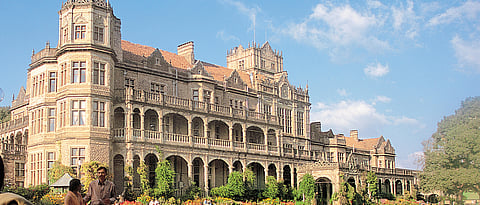
- Destinations
- Experiences
- Stay
- What's new
- Celebrating People
- Responsible Tourism
- CampaignsCampaigns
- SubscribeSubscribe
- Buy Now

Now that summer's here, a trip or three to the hills would be just what the doctor ordered. And for a great hill station experience, you couldn't do much better than heading to Shimla. After all, the British made the city the Raj's summer capital for a reason. Even though the Shimla of today is crowded and often a little dingy, remember that the city boasts of some fantastic hill walks. Here are some of them. Read on and plan your holiday right now
The Mall Just walking up the Mall Shimlas main street you come across the strangest sights. Arguably the oddest of all is the Anglican Christ Church, where the vicar once preached a sermon against the enormity of the crinoline, the extravagance of its wearers and the room it took up in the sacred edifice to the exclusion of would-be worshippers the following Sunday all the women appeared in their riding habits. The side door to the church is normally open and if this is locked, you may ask the rector for the key. He lives in the dressed stone house by the church, where the doorway has a charming little sundial over it.
A little way down the Mall is the Gaiety Theatre, the place for amateur theatricals during the Raj. The theatre is tiny, just nine rows deep, 12 seats across, with the box of honour for the viceroy and his staff still containing its full complement of faded, crested chintz armchairs. You could easily spend a whole day in here studying the production photographs wonderfully whacky images of plays that must have been outdated well before they were performed in 1927. Under titles such as The Fatal Nymph and Dear Brutus, tall men with false moustaches are pictured kneeling down, proposing marriage to comely girls in flapper hats, while conspiratorial housemaids in starched linen hold up the vicar out in the front hall. The players on Gaietys stage have included Rudyard Kipling while the viceroy, Lord Lytton, wrote and staged the play Walpole.
At the end of the Mall promenade also lies Scandal Point, a memory of Shimlas once libertine lifestyle. For tame as it may appear today, Shimla was in some ways a sort of red light district for the Raj. In Kiplings Plain Tales From the Hills, the same plot repeats itself over and over again after the boredom of a remote posting, the young Englishman goes up to Shimla where, bowled over by the sudden glut of fair young English women, he falls in love with a Mrs Hauksbee or a Mrs Reiver one of the towns carnivorous memsahibs. Once as chic as any street in the empire, the Mall is just a memory now. But even today it is one the longest stretches of open-air, purely pedestrian shopping in the world and forms the core of the notified Heritage Zone of Shimla. The horse rides and ice-cream vendors draw children.
Close by is Lakkar Bazaar, once famous for woodwork, with several souvenir shops.Theres an ice-skating rink on the slope below Scandal Point.
Jakhoo Hill, towering over the ridge, is Shimlas highest point, with a Hanuman Temple on top. Sunset views here are especially magnificent during the monsoons. En route to the temple is Rothney Castle, residence of AO Hume, believed to be the founder of the Indian National Congress. While the route from the ridge is the standard one, a track variation may be made from Sanjauli to pass through a thick wood of oak, rhododendron and cedar.
The old Viceregal Lodge on the Observatory Hill is perhaps the most resonant of old structures in Shimla. Its a grim Scotch baronial confection variously compared to a lunatic asylum and Londons Gothic St Pancras Station. For despite appearances, there was always a deadly serious side to Shimla. The viceroy was the spider at the heart of Shimlas web. From his chambers in the Viceregal Lodge, he pulled the strings of an empire that stretched from Rangoon in the east to Aden in the west. Shimla may have looked like some English seaside resort, but the town was in fact one of the great political capitals of the world At its height it was nearly as powerful as Paris and Berlin. Among the events that played out here was the momentous decision taken to partition India. In the evenings, the viceroy would hold balls as grand as anything thrown by the Russian Tsar, his only rival in Asia At the Viceroys evening parties, wrote Aldous Huxley, the diamonds were so large they looked like stage gems. It was impossible to believe that the pearls in the million-pound necklaces were the genuine excrement of oysters. Today the Viceregal Lodge houses the Indian Institute of Advanced Studies. When the lodge was first built, Londons smartest outfitters, Maples of London, supplied the furnishings, and it was said that the Indian income-tax was introduced to pay for it all. Though little of that old glory remains, one can still walk around in some portions of the first floor, including the main halland a small museum, which are accessible on a nominal ticket. The institute is surrounded by attractive grounds while the hill has some good short walks.
If you go there by foot, there are interesting stops on this 2-hour walk from the Mall. St Michaels Cathedral was built for the towns Catholic community by Lord Ripon, whod turned Catholic at 46. A little ahead is Gorton Castle, secretariat of the Imperial Government of India. Further on, Himachal State Museum has a display of the states cultural and archaeological heritage. The gallery on miniature paintings is especially noteworthy. Inverarm, the building that holds the museum, once housed a member of the viceroys Council.
